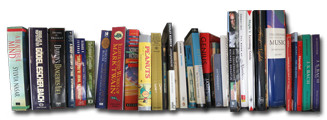
elf's Bookshelf
This page lists books I've recently read, along with a brief comment about them and a score rating them. These are not so much reviews as they are fleeting glimpses. While I read non-fiction for pure knowledge, I read novels for pure enjoyment, but the side-effects are just as valuable; the most important of which is distracting my brain from problems I am trying to solve, pushing them into my subconscious and leading to solutions faster than if I actively thought about them (answers usually arrive while I am in the shower or while walking home from work).
SCORING:
For non-fiction, the scoring is out of four, with 1 point (sometimes more, indicated by "+"s) each, for: content (whether it was informative), writing (whether it was easy to read), production quality (editing, design), and whether I enjoyed reading it.
For fiction (also out of four), points are awarded for: enjoyment, ideas (I find that when I read fiction, my mind tends to find solutions to problems I am working on, faster), vocabulary (whether I learned new words) and notable quotations (for my personal database).
• Annihilation • Understanding Exposure • The Photography Book • EF Lens Work III • A Distant Mirror • Ghost Wars • All That is Solid Melts into Air • Musicophilia • Austerlitz • American Pastoral • Flaubert's Parrot • The Innovator's Dilemma • Ventus • Legacy of Ashes • Before And After Page Design • God's Secretaries • The Emergence of Probability • Brother Astronomer • The Book of Numbers • Zero: The Biography of a Dangerous Idea • American Prometheus • See No Evil • The First World War • From Eros To Gaia • Empires of the Word • Architecture: World's Greatest Buildings • Abel's Proof
“Annihilation” by Jeff Vandermeer
Score: 3/4
• content: 1 • writing: .5 •
production: 1 • enjoyment: .5
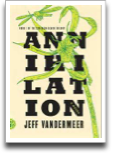
The most surprising things about this book was that I read it in a single day– starting at 10:30AM on a Sunday morning and finishing at 12:30AM early Monday morning before going to bed. The second surprising thing is that I only saved two excerpts/phrases that I enjoyed– the writing is straightforward, without eloquence or literary embellishments.
The story takes place over the course of a few days and races towards the conclusion with many unanswered questions that make a compelling case for reading the pair of sequels.
The story is quite simply about a groups of nameless female explorers of an ecological disaster referred to as Area X. The expeditions are funded by the government. The exploration teams (both current and previous) consist of a psychologist (the team leader who is also a hypnotist) and various combinations of anthropologists, biologists, surveyors, linguists and doctors– not the usual assortment of skills one would expect in a expedition to an ecological disaster. Even stranger is that the team members do not know each others names.
The book's narrator is a woman, but the voice is male. At no time did I feel that the author managed to write in a woman's voice nor that he had ever been camping. But the imagery that remains is very vivid and intriguing. I made it to the end of the book without wanting to throw it across the room and I wanted to find out what happened after the book ended. It was a very satisfying read despite the deficiencies.
“Understanding Exposure” by Bryan Peterson
Score: 3/4
• content: 1 • writing: .5 •
production: 1 • enjoyment: .5
It is difficult to measure the usefulness of this book as a whole because I happened to read Peterson's two-part tutorial on exposure, excerpted from this book, on photo.net. The online tutorials were very useful to me, as a beginner DSLR photographer; I always recommend them to other beginner photographers.
This book was written in the days of film photography and advice about digital photography was an addendum in the revised edition. The discussion on the role that ISO settings play in exposure is limited to film and the importance of using in-camera histograms is ignored completely. His suggestion of using f/22 apertures don't really apply to crop-sensor DLSRs and could lead to many disasters for the unknowing beginner. As such, this book is a good starting place to understanding digital photography but needs to be supplemented by other material (I have relied the internet for supplemental information).
One thing I found puzzling as I read through the book was why the author kept using particular settings for his photographs— there was no explanation forthcoming until half-way through there was an "A HA!" moment— I don't remember whether it was explained or whether the explanation dawned on me. I only remember that it bothered me (a nagging feeling) as I read though the book. I would have preferred if the explanation was up-front.
I did learn things I didn't know about various kinds of filters and I am able to tell when a photographer used one and when a photograph turned out poorly because the photographer didn't use one.
“The Photography Book” by The Editors of the Phaidon Press
Score: 2.5++/4
• content: 1++ • writing: .5 •
production: 0 • enjoyment: 1++
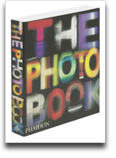
Most everyone who was born after the 1980s recognizes the photograph of the sailor kissing the nurse in Times Square, on the day the Second World War ended, but it is doubtful they can name the photographer. There are many photographs like this which we recognize but forget that someone very good at what they do, actually took them.
The Photography Book is a great introduction to the photographers and their photographs since the dawn of photography as an art medium and a photojournalistic medium. It has an alphabetical listing of 500 photographs with a brief description of the photograph, its importance to photography and a brief biography of the photographer. The book also contains a useful glossary of photographic techniques and terms.
The version I am reviewing is a compact, pocket version of The Photography Book and this small size makes it difficult to fully appreciate many of the photographs which are meant to be viewed in larger scale because of all the detail they contain; however, it does makes the book easily portable.
I would recommend this book to students new to photography and hobbyist photographers who are unfamiliar with the history of photography; readers should be cautioned that the book contains photographs of nudes (both male and female), of corpses and of war.
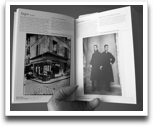
This book was begun with great intentions but the end result is flawed for many reasons, most of them typographic: the typeface selected for the descriptive text is difficult to read on the glossy paper; the photographer's name on the right-hand page is cut-off due to the binding; the right-hand pages should have been laid out as a mirror of the left-hand page; there was no need to write the photographer's last name first followed by the first name in a smaller font; the title of the photograph should have been italicized; there was no need to repeat the photograph's title at the bottom of each page.
The descriptive text is not uniformily excellent; most of the descriptions do not provide any insight into the photograph or the photographer. In deciding to buy this book I read some reviews that complained at the selection of photographs and choice of photographers. Since I lack the knowledge and expertise in this field, I cannot comment on this aspect.
If the book is graded solely as a great resource that inexpensively collects 500 great photographs, then it succeeds despite its flaws.
Thu Jul 16 22:25:24 2009: Julius Shulman, famous architecture photographer,who passed away today, is not mentioned in the Photo Book.
“EF Lens Work III” by Canon Inc. Lens Products Group
Score: 3/4
• content: 1 • writing: 1 •
production: 0 • enjoyment: 1

Canon's primer on camera lens optics is available for download in PDF format (11 chapters).
The beautiful photography of the introductory first chapter, The EF Lens Concept, is equaled only by the marketing hyperbole of the accompanying captions.
The second chapter, Canon's Challenges, begins with the history of Canon:
Kwanon, the Buddhist Goddess of Mercy, was chosen as the name for the first Japanese 35mm focal plane shutter camera. Here is the story of how the Kwanon came to be developed and how it got its name...
Other hilights include the explanation that the "L" lens designation stands for "luxury"; a catalog of Canon's lenses through the history of the company, including the 1961 release of the 50mm f/0.95, reputed to be, "brighter than the human eye". There is also a catalog of all the cameras from 1930 until the 2006 release of the 450D.
Sun Mar 08 09:14:59 2009: The third chapter, The EF Lens World, is an introduction to Canon's prime lenses showcasing each lens (from the 15mm fisheye to the 600mm telephoto) with a sample photograph and technical details about the lens. I found the tilt-shift lens pages more interesting than the rest, especially the explanations on how the lens was used to take the showcase photograph (I wish it had more detail on how the TS lens worked mechanically).
I skipped the subsequent chapters dealing with zoom lenses, EF-S crop-factor lenses and camera accessories.
I wish I had seen chapter seven, The Basics of Interchangeable Lenses & Correspondence of EF Lenses to Digital Photography when I first bought my DSLR. It is a great introductory chapter to DSLR photography with photographs illustrating field of view of a range of lenses the crop-factor and the concept of aperture. (There are a few minor spelling and grammatical errors).
Chapter eight, Photo Techniques, describes the lenses that could be used used to photograp portraits (including soft-focus), macro photography (I am still unclear on the difference between a normal lens and a macro lens), landscapes, underwater photography and wildlife photography.
The final two chapters are extremely technical in nature— chapter nine, EF Lens Technology describes how EF lenses are designed with computer-aided modelling, and chapter ten, Optical Terminology is a comprehensive glossary of terms dealing with optics and photography and MTF charts for all the lenses.
A note on typography: although this book is well layed-out, the typography is appalling; the text is justified; the chosen font is difficult to read with nearly invisible punctuation and the leading is so narrow that I had to backtrack several times because I had skipped a line after getting to the end.
“A Distant Mirror” by Barbara Tuchman
Score: 5/4
• content: 2 • writing: 1 •
production: 1 • enjoyment: 1
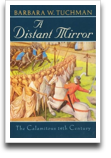
“For belligerent purposes, the 14th century, like the 20th, commanded a technology more sophisticated than the mental or moral capacity that guided its use.”
I decided to read this book based on a suggestion by the film historian, Peter Cowie, during his audio commentary on the Criterion Edition's The Seventh Seal. “A Distant Mirror” is a history of Europe in the 14th century, a time when the two major concerns were entrance into Heaven (due to the dilemmas of the two Popes, posed by the Schism) and the plague that killed 30% of Europe. The exquisitely researched book details all aspects of life in the 14th century including dress, diet, morals, religion, sex, warfare, birth and death.
It is remarkable that this book caused the most response from complete strangers— first, on the #emacs channel, it was recognized as an excellent book; and second, I was approached on the street by some random person who pointed to the book and wanted to chat about it; I ignored him.
Theology being the work of males, original sin was traced to the female. Had not a woman's counsel brought first woe by causing Adam to lose Paradise? Of all mankind's ideas, the equating of sex with sin has left the greatest train of trouble. In Genesis, original sin was disobedience to God through choosing knowledge of good and evil, and as such the story of the Fall was an explanation of the toil and soeeow of the human condition. In Christian theology, via St. Paul, it conferred permanent guilt upon mankind from which Christ offered redemption. Its sexual context was largely formulated by St. Augustine, whose spiritual wrestlings set Christian dogma thereafter in opposition to man's most powerful instinct. Paradoxically, denial became a source of attraction, giving the Church governance and superiority while embedding its followers in perpetual dilemma.
Doctrine tied itself into infinite knots over the realities of sex. If the sacrament of marriage was holy, how could sexual pleasure within marriage be sinful? If enjoyment was venial sin, at which point did it become concupiscence, or immoderate desire, which was mortal sin? Was bearing a child outside marriage, though, procreative, more sinful than intercourse, only for pleasure within marriage? Was a chaste or virgin marriage, though non-procreative, more holy than marital intercourse? What if a man slept with his wife when she was pregnant or after menopause when procreation could not be the purpose? Or, being tempted by another woman, slept with his wife to "cool off" illicit desire: that is committed one sin to avoid another? Or departed on crusade without his wife's consent or without taking her along, which was anti-procreative, yet i the interests of the Church? These were questions that concerned the dialecticians probably more than the average person.
The obsession with sorcery in Charles's case reflected a rising belief in the occult and demonic. Times of anxiety nourish belief in conspiracies of evil, which in the 14th century were seen as the work of persons or groups with access to diabolical aid. Hence the rising specter of the witch. By the 1390s witchcraft had been officially recognized by the Inquisition as equivalent to heresy, The Church was on the defensive, torn apart by he schism, challenged in authority and doctrine by aggressive movements of dissent, beset by cries for reform. Like the ordinary man, it felt surrounded by malevolent forces of which sorcerers and witches were seen as the agent carrying out the will of the Evil One.
“Ghost Wars” by Steve Coll
Score: 7/4
• content: 2 • writing: 2 •
production: 1 • enjoyment: 2
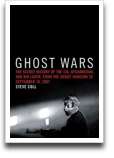
The CIA's mission was to prevent surprise attacks. In this it was joined by the eavesdropping National Security Agency and the intellignce arms of the Pentagon, State, FBI and other departments. Many of the thosands of analysts, linguists, technicians, communicators and operations officers employed in the intelligence bureaucracy spent their time on soft analytic subjects such as political and scientific trends. A sizable minority assessed and disseminated all credible evidence about active threats to American lives or facilities. This massive warning bureaucracy had been honed during the Cold War to protect the United States against a sudden nuclear strike. By 1998 it directed much of its attention to fragmentary evidence about terrorist threats. In physical form, the system was a network of classified computer systems, fax machines, videoconference facilities and other secure communications that linked American embassies and military bases worldwide with government offices in and around Washington. The network allowed for fast, secure distribution of classified warning reports between the CIA, the White House, the FAA and thousands of local U.S. law enforcement agencies. The rules for writing, categorizing and distributing these daily warning erports were specific and routinized. What the specialists called "raw" or unedited intelligence— intercept transcripts and notes from interrogation reports— might be set to one distribution list of professional analysts. "Finished" product, more carefully written and edited but also sometimes flat and homogenized, poured out by the ream to policy makers.
It was a vast, pulsing, self-perpetuating, highly sensitive network on continous alert. Its listening posts were attuned to even the most isolated and dubious evidence of pending attacks. Its analysts were continually encouraged to share information as widely as possible among those with appropriate security clearances. History had taught the professionals who worked inside the warning network that even the most insignificant bits of evidence could occasionally provide a clue that stopped a catastrophic attack. Human nature led them to err heavily on the side of caution as they decided what information to pass along. No analyst wanted to be the one who mistankely discounted an intercept that might have stopped a terrotist bombing. From George Tenet to the lowest-paid linguist in the Counterrorist Center, the system was biased toward sounding the alarm. It was an imperfect arrangement, many on the inside believed, but it was the only way to ensure that the intelligence community did all it could to detect surprised before they erupted.
Of course, history has shown that the CIA failed catastrophically in their mission and is now irrelevant as an intelligence gathering organization.
This book traces the beginning of the threat with attacks on the US embassy in Iran, back in the 80s, until September 8th, 2001. It is suberbly well researched and exquisitely detailed. It deservedly won the Pulitzer. It offers a slightly different view than that of Legacy of Ashes ( reviewed below) where the blame is left solely at the feet of the CIA; Ghost Wars, describes a world where the CIA was up against forces much greater than its capabilities and nothing it did would have mattered.
“All That is Solid Melts into Air” by Marshall Berman
Score: 1/4
• content: 1 • writing: 0 •
production: 0 • enjoyment: 0
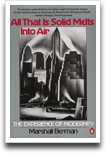
I stopped reading this book after about 50 pages. The writing style was so ponderous that I was forced to read each sentence several times before I could begin to understand its meaning. Also, the poor typesetting gave me a headache— it could have used more white-space and leading.
Regrettably, I neglected to transcribe an excerpt to illustrate the excerable writing.
“Musicophilia” by Oliver Sachs
Score: 6/4
• content: 2 • writing: 1 •
production: 1 • enjoyment: 2

This is one of the most enjoyable books I have read in a long time, and the first one authored by Sachs. It is a collection of anecdotes, related to music and the brain.
Since the mid-1990s, studies carried out by Robert Zatorre and his colleagues, using increasingly sophisticated brain-imaging techniques, have shown that imagining music can indeed activate the auditory cortex almost as strongly as listening to it...
Jerome Bruner, a very musical friend, described to me how once, having put a favourite Mozart record on his turntable, he listened to it with great pleasure and then went to turn it over to play the other side— only to find that he had never played it in the first place.
Until I read this book, I had a strong belief that the Vinge Singularity would eventually come true after the birth of the first AI. But after reading this book, I have re-considered that belief and doubts that something as complex as the brain can be re-created in silicon. Goedel's Uncertainty Principle is the ultimate barrier— if we use our brain to understand how it itself works, we can never be sure that our understanding of the workings is correct. I also found some of the footnotes more interesting than the anecdotes; for example, the Guitar Hero game was a result of a music research project at the MIT Media Lab. The (so-called) Mozart Effect is also mentioned:
It has been said that even a brief exposure to classical music can stimulate or enhance mathematical verbal and visuaspatial abilities in childen— the so-called Mozart effect. This has been disputed by Schellenbert and others, but what is beyond dispute is the effect of intensive early musical training on the young, plastic brain. Takako Fujioka and her colleagues, using magnetoencephalography to examine auditory evoked potentials in the brain have recorded striking changes in the left hemispere of children who have had only a single year of violin training compared to children with no training.
“Austerlitz” by W.G. Sebald
Score: 2.5/4
• enjoyment: 1 • ideas: 1 •
vocabulary: .5 • quotations: 0
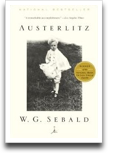
This short novel is a translation from the German by Anthea Bell (who is famous for the translations of the Asterix and Obelix comics) and even though she is a capable translator, I found it lacking in emotion. One notable thing about this book is that it contains photographs illustrating the various subjects mentioned throughout the narration (though no comment is made on the origins of the photographs).
The mere idea of listening to anyone brought on a wave of revulsion, while the thought of talking myself, said Austerlitz, was perhaps worse still, and as this state of affairs continued I came to realize how isolated I was an always have been, among the Welsh as much as among the English and French. It never occured to me to wonder about my true origins, said Austerlitz, nor did I ever feel that I belonged to a certain social class, professional group or religious confession. I was ill at ease among the artists and intellectuals as in bourgeouis life, and it was a very long time sicne I had felt able to make personal friendships. No sooner did I become acquainted with someone than I feared that I had come too close, no sooner did someone turn towards me than I began to retreat. In the end I was linked to other people only by certain forms of courtesy which I took to extremes and which I know today, said Austerlitz, I observed not so much for the sake of their recipients as because they allowd me to ignore the fact that my life has always, for as far back as I can remember, been clouded by an unrelieved despair.
“American Pastoral” by Philip Roth
Score: 4/4
• enjoyment: 1 • ideas: 1 •
vocabulary: 1 • quotations: 1
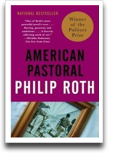
I began reading American Pastoral a few days before Gore Vidal's interview appeared in a recent "New York Times Magazine", where he dismissed Philip Roth as a "comic writer". I hadn't realized that American Pastoral was a funny book until he pointed it out, even though I laughed out loud a couple of times while reading it, because I wasn't expecting a "funny" book to win the Pulitzer. Then, half-way through the book, I realized that the "Simpsons" writers had parodied American Pastoral in the episode where Homer meets his estranged mother.
The most notable aspects of this book would have the be the shortest opening sentence ever— "The Swede."— which wins over, "Call me Ishmael." (I can now look forward to reading the single-word opening sentence) and the detailed explanation of the craft of glove-making.
I couldn't find a passage worth quoting in my review because Roth's prose lacked that certain lyricism that I seek when choosing an excerpt. His prose is what I would call straight-forward.
“Flaubert's Parrot” by Julian Barnes
Score: 6/4
• enjoyment: 2 • ideas: 2 •
vocabulary: 1 • quotations: 1
Gustave taught Caroline about literature. I quote her: 'He considered no book dangerous that was well written.' Move forward seventy years or so to a different household in another part of France. This time there is a bookish boy, a mother, and a friend of the mother's called Mme Picard. The boy later wrote his memoirs; again, I quote: 'Mme Picard's opinion was that a child should be allowed to read everything. "No book can be dangerous if it is well written".' The boy, aware of Mme Picard's frequently expressed view, deliberately exploits her presence and asks his mother's permission to read a particular and notorious novel. 'But if my little darling reads books like that at his age,' says the mother, 'what will he do when he grows up?' 'I shall lie them out!' he replies. It was one of the cleverest retorts of this child; it went down in the family history, and it won him— or so we are left to assume— readership of the novel. The boy was Jean-Paul Sartre. The book was Madame Bovary.

There was a time in my life when I avoided reading literary fiction, written about historical events, but sprinkled with plausible fictions dreamt-up by the author. I decided that my brain cells were far too valuable to waste on reading pseudo-imaginary events and that they should instead be used to store factual and valuable information. The only fiction I read was hardcore SF, having convinced myself that they were stories about a future that would very likely come true.
I changed my mind when I realized that first, having Google and the Wikipedia readily available, meant that I no longer had to remember facts because I could always look them up. Second, the side-effects of reading fiction had benefits— subconsciously solving problems, improved vocabulary and useful quotations— and third, it no longer mattered that the stories contained un-truths. In the following excerpt, it doesn't matter whether the language of flowers exists because if I casually mentioned the it during a conversation, and provided examples, people would believe that it existed because it is completely plausible that such a thing could exist. And if it really didn't exist, they would simply will it into existence, just so they could tell someone else about it.
I wandered in the park and picked a convolvulus for Gustave. I must tell you he was always vulgarly ignorant about flowers. Not the botanical aspect— he probably learned all about that at some stage, as he learned aboutmost other things (except the heart of a woman)— but their symbolic aspect. It is such an elegant tongue; the language of flowers: supple, courtly and precise...
Gustave understood none of this. He was the sort of person who might, after much hard study, have finally learnt two phrases from the languge of flowers: the gladiolus, which when placed at the centre of a bouquet indicates by the number of its blooms the hour for which the rendezvous is set; the petunia which announces that a letter has been intercepted. He would undertand such rough and practical uses. Here take this rose (no matter what colour, though there are five different meanings for five different roses in the language of flowers): put it first to your lips and then place it between your thighs. Such was the fierece gallantry of which Gustave was capable. He would not, I am sure, have understood the significance of the convolvulus; or, if he had made any effort, he would still have got it wrong.
I would always look forward to reading Julian Barnes' "Letters from London" column for the New Yorker magazine.
“The Innovator's Dilemma” by Clayton Christensen
Score: 6++/4
• content: 2+ • writing: 1 •
production: 1 • enjoyment: 2+
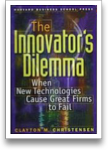
This is an amazing book! It explains why certain companies are on top today but won't be tomorrow; why Google has the 20% personal project rule; why Apple succeeded making the iPod a synonym for "MP3 player"; and why companies that were on top ten years ago, are going to be irrelevant today. The most amazing thing about this book is that it was written more than ten years ago, in 1997, and is still relevant today (it is published by the Harvard Business School Press).
One of the surprise lessons in this book is that companies should not address customer needs— specifically, their future needs. Customers typically know what they need today or perhaps next year. They do not know what they will need in 10 years or how the industry will be shaped in that time and if they do tell you, don't listen to them!
This book is about the failure of companies to stay atop their industries when they confront certain types of market and technological change... Companies stumble for many reasons, of course, among them bureaucracy, arrogance, tired executive blood, poor planning, short-term investment horizons... But this book is not about companies with such weaknesses: It is about well-managed companies that have their competitive antennae up, listen astutely to their customers, invest aggressively in new technologies, and yet still lose market dominance...
Successful companies have a practiced capability in taking sustaining technologies to market, routinely giving their customers more and better versions of what they say they want. This is a valued capability for handling sustaining innovation, but it will not serve the purpose when handling disruptive technologies. If as most successful companies try to do, a company stretches or forces a disruptive technology to fit the needs of current, mainstream customers— as we saw happen in the disk drive, excavator and electric vehicle industries— it is almost sure to fail. Historically, the more successful approach has been to find a new market that values the current characteristics of the disruptive technology. Disruptive technology should be framed as a marketing challenge, not as a technological one.
In many instances, the information required to make large and decisive investments in the face of disruptive technology simply does not exit. It needs to be created through fast, inexpensive and flexible foray into the market and the product. The risk is very high that any particular idea about the product attributes or market applications of a disruptive technology many not prove to be viable. Failure and interactive learning are, therefore, intrinsic to the search for success with a disruptive technology.
“Ventus” by Karl Schroeder
Score: 5+/4
• content: 1 • writing: 1 •
production: 1 • enjoyment: 2+
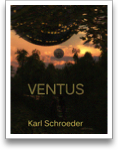
I don't know whether it's just a coincidence that both Bill Joy's famous article in "Wired" magazine, about the dangers of nanotechlogy, and Ventus were published in 2000. I started reading this free ebook (HTML version) on Good Friday and was finished by Easter Sunday. I think it would be a difficult book to read in small portions; each of the three sections, if not the entire book, should be read in a single sitting. I enjoyed this book tremendously and recommend it (it passed the Opening Sentence Test). It starts out, as many sword-and-sorcery fantasy books begin, in a primitive village but the reader quickly realizes that there is more to this planet than the inhabitants realize.
The advanced technology that appears is similar to that in William Gibson's worlds— it is plausible and works flawlessly for the purposes it was designed ("it just works") and those who do not posses it, are at a definite disadvantage. It is not however, completely hardcore science-fiction, of the kind that Arthur C. Clarke wrote, but I was willing to accept the fantasy in return for satisfying entertainment and a few of the characters and scenes are not as vivid as the rest of the book. I was suprised that Karl Schroeder is a Canadian who was born in a Mennonite community in Manitoba (one does not typically associate technological sophistication with Mennonites or Canadians).
NOTE: This is the first work of fiction being reviewed here. I typically prefer reading biographies and my interests are limited to history, math and physics, with small detours into architecture and design. My return to fiction, began with Gravity's Rainbow, which will appear here, when I have decided I have something interesting to say about it.
“Legacy of Ashes” by Tim Weiner
Score: 4++/4
• content: 1+ • writing: 1+•
production: 1 • enjoyment: 1
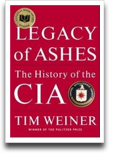
I often remind my boss that he should consider a career with CSIS (Canadian Security and Intelligence Service, the equivalent of the CIA and MI6) because he has all the qualifications— a Masters degree, he speaks only one language, he understands only one culture, and he's caucasian. (I said it with such conviction, the first time, he was unsure whether I was being serious or being sarcastic.)
While See No Evil explains the reasons for the tragic aftermath of the CIA's reliance on electronic intelligence (spy satellite, and eavesdropping on communications— a role traditionally filled by the NSA) and not enough street intelligence, Legacy of Ashes begins at the inception of the CIA and shows that the CIA was created with conflicting mandates and that the CIA's image as a superb intelligence agency is merely a fabrication— propaganda— created by the agency itself.
After reading this book, you might be forgiven in thinking that C.I.A. stood for the, "Completely Inept Agency", as fiasco after fiasco are revealed in shocking detail— shocking not only because of the waste of money, but also (more so) because of the waste of human life. It would surprise me if this book did not win the Pulitzer prize for its comprehensive history of the Central Intelligence Agency.
Update Tue Jun 30 23:00:47 2009: The CIA released a statement and a reviewed the book.
After having read Ghost Wars, which covers some of the same ground, I would have to agree with the CIA articles that Legacy of Ashes is biased against the CIA— it is not a definitive history of the agency or its failures.
Update Tue 05 Jul 2011 06:33:34 PM EDT: The CIA redeemed itself with the capture of Bin Laden with excellent detective work (which will eventually become public after a few decades have passed).
“Before And After Page Design” by John McWade
Score: 5+++/4
• content: 1+ • writing: 1+ •
production: 2 • enjoyment: 1+

If you write reports, buy this book; if you publish a newsletter, buy this book; if you design websites, buy this book; if you design business cards and stationery, buy this book; if you design forms, buy this book. It is one of the most useful books I have bought. I love this book because it is one of the most beautifully designed books I have read and if you are a beginner, you can start using ideas in this book by page 3. I read it in a day and after I finished, I turned back to the beginning and started again. Within a week, I had re-designed one of the departmental forms used to request new accounts.
If you are interested in design, buy this book. It teaches you to look critically at printed documents and shows how to improve the layout by showing how a document looked before it was improved, the changes that were made to improve it and more importantly, why the changes improved the document.
It doesn't discuss websites specifically, but many of the fundamentals that apply to the printed page can be applied to a webpage; I didn't know that the left margin of the callout quote is set at the half-column mark (I couldn't understand why my callout quotes "looked wrong" when they spanned the width of the entire document.)
After reading this book, I look at the world in a different light— the hideously ugly sign in the lower concourse of Union Station I walked by without noticing; the newly designed Sunday bulletin at St. Michael's cathedral with 300 dpi grey shading behind gothic blacklettered headings; one of the ads in the last Sunday's Arts and Leisure of the New York Times.
[The timeline is late 1985]
Apple Computer phoned. "We hear you're doing good things with PageMaker and we'd like to pt you on videotape. Would you be up for that?" said the voice. They helicoptered a four-man crew to PageLab— a closet-sized room (I mean it)— and filmed away. The footage became part of Apple's first desktop publishing video and was seen around the world.
Apple phoned. "Will you make pages with PageMaker for us?" they asked. "What would you like it to be?" I replied. "Don't know— it's for a desktop publishing forum; we hoped you'd hace some ideas." I created How to Design a Page on Saturday and on Monday drove to Cupertino with proofs. "You did this with our computer?" they asked. I was surprised by their surprise. "No one here does this, " they said. "I just used PageMaker," I said. "But you're using it," they said, "to design cool stuff."
That's where it started.
Online: Before & After Magazine
“God's Secretaries: The Making of the King James Bible” by Adam Nicholson
Score: 4++/4
• content: 1+ • writing: 1 •
production: 1+ • enjoyment: 1
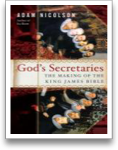
Much of the archival material that would have helped give greater depth to the story of the Translators (since they were certainly not authors) of the King James Bible was lost in a fire at Whitehall in 1698. Perhaps that is for the better, because the author of this book has instead written vividly about life in the early 1600s thus providing the reader a contextual setting for this great undertaking.
My knowledge of Elizabethan England, in particular the royal intrigues, is limited to a great movie with Cate Blanchett (whose sequel (involving the defeat of the Spanish Armada) is to premiere at the Toronto Film Festival this month and will open next month). Since the protestant Elizabeth I (daughter of Henry VIII) was childless, her cousin, the catholic Mary Queen of Scots, was next in line to the throne. However, once she was beheaded for allegedly plotting against the Queen; her son, James who was raised by Presbyterians, was now next in line. The book opens with the death of Elizabeth I in 1603 (Shakespeare wrote Othello, The Merry Wives of Windsor, Measure for Measure in 1604) and the ascendency of James I to the throne of England.
Then the cataclysm. The entire world of the translation, and of its hopes for the future, was rocked and very nearly shattered by an event which fell— or to be exact, almost fell— on Jacobean England in November 1605: the attempt by a group of desperate and marginalised Catholic renegades and romantics— terrorists is the word we would now use— to blow up the king queen, princes, peers and other members of parliament at its opening on 5 November. It would come to define Jacobean England as much as September 11 2001 would shape the attitudes, fears and methods of revenge of the western world in the first decade of the twenty-first century.
Most Jacobean English Catholics, like most twenty-first century Muslims, would not have dreamt of upsetting a status quo in which, on the whole, they thrived. But a small and alienated set of them were dreaming of a form of salvation which the everyday and rather smug ordinariness of establishment life could not provide. The state had elaborate, overlapping and interlocking security arrangements which had identified and tracked some of these subversives, and infiltrated their networks, but had not thought the threat serious enough to act against them. They had concocted small plots and conspiracies and committed minor outrages in the previous few years...There was a desire of a hope alive in the early years of James' reign, as at the turn of the third millennium, that in some ways history was over, that it was possible to accommodate all shades of opinion in one mutually beneficial society, that the threat of the Roman Church, and of Spain, its military arm, belonged to the past. Both the English and the Spanish had happily signed a peace treaty in the summer of 1604 and later trade boomed and customs dues had soared...
The terrorist attack blew that complacency apart. the king his family, his councillors and the whole range of English government had been within a few hours of death (or at least so Robert Cecil led them to imagine.) The English became fixated on homeland security.
“The Emergence of Probability” by Ian Hacking
Score: 3.8/4
• content: 1 • writing: 1 •
production: .8 • enjoyment: 1
Many modern philosophers claim that probability
is a relation between a hypothesis and the evidence for it.
—Ian Hacking
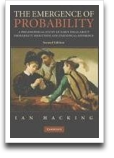
Until computers became powerful enough that weather systems could be modeled accurately, forecasting the weather was an uncertain art form. Today, weather forecasts are not completely reliable; there is always an element of chance— the butterfly effect— "we live in an universe of chance."; the best we can do is to, "infer the future from the past." Probability plays a great role in how we make decisions on what do next— in 1736, Joseph Butler said that, "probability is the very guide of life."
If we are able to predict the weather reasonably accurately, can we also predict events in the future with reasonable accuracy, given appropriately powerful computers? In Leibniz's time there were, "lesser intellectuals whose dozens of programmes for universal grammar were motivated by a belief that if only we could uncover in the collective wisdom of mankind a suitable set of ideas, then we would be able to unlock all the secrets of the universe. Universal grammar, which was recently been presented as a key for understanding mind, was in those days a project for understanding all of nature." Leibniz's theory was that given, "an objectively correct prior distribution of probability for a set of possibilities, the correct distribution of probability is the one that corresponds to the propensity of the possibility to exist— very much as in dice rolling."
“The Emergence of Probability” by Ian Hacking, traces how the concepts of probability emerged in the late 1600s from the idea that it was was immoral— attempting to divine the future was the equivalent of trying to read the mind of God, who was solely responsible for our fate— to today where probability encompasses, "ideas with which we organize our reasoning."
Given a choice about knowing the outcome of a situation, most would pick certainty over uncertainty. The most vexing of these uncertainties is whether God exists; the following excerpt is from the chapter titled, "The Great Decision," about what is known as Pascal's Wager:
'God is, or he is not', is Pascal's expression of his partition. 'Which way should we incline? Reason cannot answer.' That is, there is no valid proof or disproof of God's existence. Instead we adopt the following model: A game is on at the other end of an infinite distance, and heads or tails is going to turn up. Which way will you bet?
When Reason cannot answer, a sensible man can say that we will not play the game. But in our case, by the mere fact of living, we are engaged in play. We either believe in God or we do not...
If the chances of heads and tails are equal, and there are equal pay-offs for either outcome, it is a matter of indifference whether we bet on heads. But if heads pays twice as much as tails, then we clearly we bet on heads. In the agnostic's existential situation, the optimal pay-off, if there is a God, is salvation, of incomparably greater value. Hencem if there is an equal chance of God's existence or non-edxistence, the expectation of choosing the pious life exceeds that of choosing the worldly one. The argument from expectation concludes: act so that you will come to believe in God...
We have no good reason for picking one-half as the chance of God's existence... The argument from expectation with an equal probability distribution requires only that salvation, if God is, is more valuable than sinful pleasure, when there is no God. But salvation is infinitely preferable to the joys of the worldly life. No matter how great may be the daily pleasure of the libertine, they are finite. Salvation, according to Pascal, is infinitely blessed. Moreover, although we have no idea of the chance that God exists, it is not zero...
“Brother Astronomer” by Guy Consolmagno
Score: 3.5/4
• content: .5 • writing: 1 •
production: 1 • enjoyment: 1
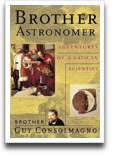
This book is a memoir of sorts of an astronomer who splits his time between the University of Arizona and the Vatican observatory, which is the Pope's summer residence. He has had a completely unremarkable (for an MIT) academic career so the book's selling point is that he happens to be a Jesuit Brother. The book consists of various talks and essays, previously given/published by the author, edited together into book form, and the intent seems to surprise the reader— the layman who has certain preconceptions about the role of science in religion. Although this is a slim book, I read it over several years; when I initially bought it, I stopped reading about half-way and then finished the rest just recently.
The most enjoyable part of the book is the author's detailed journal, in the final part, of a 1996 trip to Antartica in search of meteorites. (There is a Google Video by one of the researchers of the 2003 ANSMET, Antarctic Search for Meteorites, team). I also enjoyed the chapter "Finding God in Creation" about humankind's place in the universe— God's creation— and the importance of doing science to learn more about the universe and God. However, I was not convinced by his arguments about the Church's persecution of Galileo and the limited role of women in the Church.
“The Book of Numbers” by John H. Conway, Richard K. Guy
Score: 3/4
• content: .5 • writing: 1 •
production: 1 • enjoyment: .5

If you love numbers, or are a mathematician you will love this book; if, on the other hand, you are like me and have difficulty understanding mathematical concepts, then you will find yourself skipping many sections of this book. I did enjoy reading the chapters detailing the historical aspects of mathematical concepts but when it came time to read proofs about the concepts themselves, I skimmed the page.
“Zero: The Biography of a Dangerous Idea” by Charles Seife
Score: 4++++/4
• content: 1+ • writing: 1+ •
production: 1+ • enjoyment: 1+
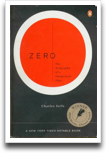
Once in a while you enjoy reading so much, that you hope it wouldn't finish. Fortunately, Zero is such a slim book (248 pages) that as soon as you finish reading it, you can go back and start reading it again. Charles Seife has managed to compress a lot of historical and mathematical information about "nothing" (zero) and "everything" (infinity) into this book. This is also the first book I've seen that was typeset using the Cochin font; it mirrors the elegance of the mathematical ideas presented. Zero has an excellent bibliography and index; and it clearly explains introductory concepts of algebra and calculus (but I'll have to re-read the section of Riemann space— complex geometry merged with imaginary numbers). One minor negative note— the information about black holes is out of date since Hawking revised his earlier statements that nothing could escape a black hole.
Fibonacci is best remembered for a silly little problem he posed in his book, Liber Abaci, which was published in 1202. Imagine that a farmer has a pair of baby rabbits. Babies take two months to reach maturity, and from then on they produce another pair of rabbits at the beginning of evety montn. As these rabbits mature and reproduce, and those rabbits mature and reproduce, and so on, how many pairs of rabbits do you have during any given month?
Well, during the first month, you have one pair of rabbits and since they haven't matured, they can't reproduce.
During the second month, you still have only one pair.
But at the beginning of the third month, the first pair reproduces: you've got two pairs.
At the beginning of the fourth month, the first pair reproduces again, but the second pair is not mature enough: three pairs.
The next month, the first pair reproduces, the second pair reproduces since it has reached maturity, but the third pair is too young, That is two additional pairs of rabbits,: five in all.
The number of rabbits goes as follows: 1, 1, 2, 3, 5, 8, 13, 21, 34, 55, ...; the number of rabbits you have in any given month is the sum of the rabbits that you had in each of the two previous months. Mathematicians instantly realized the importance of this series. Take any term and divide it by its previous term. For instance 8/5=1.6; 13/8=1.625; 21/13=1.61538... These ratios approach a particularily intersting number: the golden ratio, this is 1.16803...
Though this sequence is the source of Fibonacci's fame, Fibonacci's Liber Abaci had a much more important purpose than animal husbandry. Fibonacci had learned his mathematics from the Muslims, so he knew about Arabic numerals, including zero. He included the new system in Liber Abaci, finally introducing Europe to zero. The book showed how useful Arabic numerals were for doing complex calculations and the Italian merchants and bakers quickly seized upon the new system, zero included.
Before Arabic numerals came arounds, money counters had to make do with an abacus or a countingboard. The Germans called the counting board a Reehenbank, which is why we call moneylenders banks. At that time, banking methods were primitive. Not only did they use counting boards, they used tally sticks to record loans: a money value was written along the stick's side, and it was split into two. The lender kept the biggest piece, the stock. After all, he was the stockholder.
“American Prometheus” by Kai Bird & Martin J. Sherwin
Score: 3.5+/4
• content: 1 • writing: 1+ • production: .5 •
enjoyment: 1
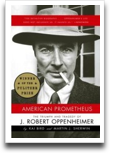
“American Prometheus” is the Pulitzer Prize winning biography of J. Robert Oppenheimer. The title of the book is adapted from a line in the September 1945 issue of Scientific Monthly— "Modern Prometheans have raided Mount Olympus again and have brought back for man the very thunderbolts of Zeus." The only fault I have with this book is that it lacks a proper index (a reduction of .5 for production); e.g. the word "Nobel" doesn't appear anywhere in the index.
The agony and humiliation that Oppenheimer endured in 1954 were not unique during the McCarthy era. But as a defendant, he was incomparable. He was America's Prometheus, "father of the atomic bomb", who had led the effort to wrest from nature the awesome fire of the sun for his country in time of war. Afterwards, he had spoken wisely about its danger and hopefully about its potential benefits and then, near despair, critically about the proposals for nuclear warfare being adoped by the military and promoted by academic strategists: "What are we to make of a civilization which has always regarded ethics as an essential part of human life [but] which has not been able to talk about the prospect of killing everyone except in prudential and game-theoretical terms?"
This is a story of a tragedy— of how prejudice can destroy the lives of innocent people. Reading this book today I can see that America has forgotten many of the ills it brought upon undeserving people; not only Oppenheimer but also the citizens of Hiroshima and Nagasaki. From the evidence presented in this book, the atomic bomb was designed to end the war in Europe (the Americans thought that the Nazi's were ahead in atomic research; it even got to the point where the OSS seriously considered either kidnapping or assassinating Heisenberg, while he attented a conference in Switzerland). Once the war in Europe ended, the Soviets became the new enemy and the bombs dropped on an already defeated Japan were more for the Soviet's benefit (as a deterrent against further agression) than as an method to force Japan's surrender.
A man's life can turn on a small event, and for Robert Oppenheimer, such an incident occured in the winter of 1942-43 in the kitchen of his Eagle Hil home, It was merely a brief conversation with a friend. But what was said, and how Oppie cohse to deal with it, so shaped the remainder of his life that one is drawn to comparisons with the tragedies of classical Greece and Shakespeare. It became known as "the Chevalier affair" and over time it took on some of the qualities of Rashomon, the 1951 film by Akira Kurosawa in which descriptions of an event vary according to the prespective of each participant.
Knowing that they would soon be leaving Berkeley, the Oppenheimers invited the Chevaliers to their home for a quiet dinner. They counted Haakon and Barbara among their closest friends and wanted to share with them a special farewell. Then the Chevaliers arrived, Oppie went into the kitchen to prepare a tray of martinis, Hoke (Haakon) followed and relayed a recent conversation he had had with their mutual acquaintance George C. Eltenton, a British-born physicist educated at Cambridge employed by the Shell Oil Company.
Exactly what each man said is lost to history; neither made contemporaneous notes of the conversation. At the time, neither appears to have considered it a momentous exchange, even though the topic was an outrageous proposal. Eltenton, Chevalier reported, had solicited him to ask his friend Oppenheimer to pass information about his scientific work to a diplomat Eltenton knew in the Soviet consulate in San Francisco.
By all accounts— Chevalier's, Oppenheimer's and Eltenton's— Oppie angrily told Hoke that he was talking about "treason" and that he should have nothing to do with Eltenton's scheme. He was unmoved by Eltenton's argument, prevalent in Berkeley's left-wing circles, that America's Soviet allies were fighting for survival while reactionaries in Washington were sabotaging the assistance that the Soviets were entitled to receive.
Chevalier always insisted that he was merely alerting Oppie to Eltenton's proposal rather than acting as his condiut. In either case, that in the interpretation that Oppenheimer put on what his friend told him. Viewing it thus— as a dead end that he had buried— allowed him to brush it aside for the time being as yet another manifestation of Hoke's overwrought concern for Soviet survival. Should he have informed the authorities immediately? His life would have been very different if he had. But, at the time, he could not have done so without implicating his best friend, whom he believed to be, at worst, and overenthusiastic idealist.
The martinis mixed, the conversation over, the two friends rejoined their wives.
“See No Evil” by Robert Baer
Score: 3.5++/4
• content: 2 • writing: .5 • production: 1 •
enjoyment: 2
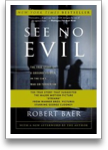
You know you're reading a good book when you get on the train, you start reading and the next thing you know the train has arrived at your stop; but you don't remember the train stopping at the other three stops along the way. “See No Evil” by Robert Baer, a former field agent in the CIA's Directorate of Operations, is such a book. If you are interested in spycraft and are a fan of Le Carré, then you will savour the many anecdotes in this book.Update Wed Jun 13 18:20:50 2007: I have revised my score from 4/4 to 3.5/4 (reduction by .5 in the writing category) after finishing the book. I found parts three and four to have sloppy editing and writing— all the players mentioned blur together without much detail. It looks like the end was rushed to meet a publication date.
The following is an excerpt from the Preface:
A lot of us who spent time on the ground in the Middle East worried that something big and bad was in the offing. There was too much hatred out there, and too many means of destruction to keep the bubble of American innocence from bursting. But I don't think anyone saw with any precision the September 11 attacks on the World Trade Center and the Pentagon coming. Even by the standards of terrorists involved, the scale of the assault was almost unimaginable. The point, though, is that we didn't even try to find out what was headed our way.
Like the rest of Washington, the CIA had fallen in love with technology. The theory was that satellites, the Internet, electronic intercepts, even academic publications would tell us all we needed to know about what went on beyond our borders. As for Islamic fundamentalists in particular, the official view had become that our allies in Europe and the Middle East could fill in the missing pieces. Running our own agents— our own foreign human sources— had become too messy. Agents sometimes misbehaved, they caused ugly diplomatic incidents. Worse, they didn't fit America's moral view of the way the world should run.
Not only did the CIA systematically shed many of its agents it also began to ease out many of their onetime handlers: seasoned officers who had spent their careers overseas in the hellholes of the world. In 1995, the agency handed the title of director of operations— the man officially in charge of spying— to an analyst who had never served overseas. He was followed by a retiree and he retiree by an officer who had risen through the ranks largely thanks to his political skills. In practical terms, the CIA had taken itself out of the business of spying. No wonder we didn't have source in Hamburg's mosques to tell us Muhammad Atta, the presumed leader of the hijacking teams on September 11, was recruiting suicide bombers for the biggest attack ever on American soil...
This memoir, I hope, will show the reader how spying is supposed to work, where the CIA lost its way, and how we can bring it back again. But I hope this book will accomplish one more purpose as well: I hope it will show why I am angry about what happened to the CIA... I'm incensed, and I think we should all be incensed, that the courageous passengers of United Airlines Flight 93 were the White House's first and only line of defense on September 11— not the CIA or the FBI or the Immigration and Naturalization Service or any other office or agency that we pay our taxes to support.
“The First World War” by John Keegan
Score: 2.5/4
• content: 1 • writing: .5 •
production: 0 • enjoyment: 1
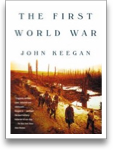
The biggest disappointment with this book (paperback edition) was that it was poorly edited and the maps had numerous errors. I would have also have preferred a bit more analysis along with the history. It should be noted that the description of the Battle of Jutland is evocatively written. The historical facts are presented clearly and the book can be used as a good overview (the battle of Vimy ridge is given one paragraph) of the events that culminated in the signing of the Versailles Treaty, as described in Margaret MacMillan's “Paris 1919” (which I began reading before this book and which remains unfinished) and then continued to unfold in the Second World War.
If the war of 1914 was not a war which the armies of Europe were ready to fight, that was not so with Europe's great navies. The armies, as the opening campaigns had proved, were technically equipped to solve certain easily perceived problems, in particular how to overcome the defences of modern fortresses, how to move vast numbers of men from home bases to the frontiers and how to create impassable storms of rifle and field-artillery fire when those masses came into contact with each other. They were quite unequipped to deal with the unperceived and much more critical problems of how to protect soldiers from such fire storms, how to move them, under protection, about the battlefield, indeed how to move them at all beyond railhead unless on their feet, and how to signal quickly and unambiguously betwen headquarters and units, between unit and unit, between infantry and artillery, between ground and the aircraft and with which, almost fortuitously, the armies had so recently provided themselves.
The failure of the generals of 1914 had largely been a pre-war failure. They had the wit to adapt the technologies ready to hand, particularily that of Europe's many-branched rail network, to their purposes. They had lacked the wit to preceive the importance or potentialities of new technologies, among which the internal combustion engine and wireless-telegraphy, as radio was then called, would prove the most important; they had, indeed, lacked altogether the wit to perceive the problems to which such new technologies would be the solution. No such charge could be laid against the admirals of the years before 1914. With foresight they had divined the significance of the developing technologies likely to affect theit service and had applied them to it with exactitude...
Nineteenth-century admirals are commonly thought to have opposed transition from sail to steam as fiercely as general opposed to the abolition of scarlet coats. Nothing could be further from the truth. When the admirals of the Royal Navy were persuaded that sail had had its day, they displayed a ruthless lack of sentimentality for the beauty of the pyramids of canvas. The sailing navy was abolished almost overnight after the Crimean War, in which steam gunboats had devastated wooden walls. Warrior, the Royal Navy's first steam ironclad of 1861, was not an experimental but a revolutionary ship, which surpassed several intermediate stages of naval design in a single leap...
Naval design changed with almost bewildering rapidity between 1860 and 1914, from broadside to central battery to turret arrangement of guns, from all-round to "citadel" to "armoured deck" arrangements of protection, from wrought-iron to case-hardened to composite quality of armour, from piston to turbine engine power, from coal propulsion to oil.
The changes came faster and faster, as admirals accepted the significance of the new technologies civilian industry was creating and took stock of the evidence presented by the clash of such technologies in engangements between navies in non-European waters...
“From Eros To Gaia” by Freeman Dyson
Score: 4/4
• content: 1 • writing: 1 •
production: 1 • enjoyment: 1
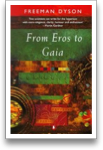
“From Eros To Gaia” by Freeman Dyson, is a collection of essays, book reviews and speeches on various topics (usually related to science). This excerpt is from an essay, "Human Consequences of the Exploration of Space", written in 1968:
It seems plausible that the best recipe for human cultural progress would read roughly as follows: take a hundred city-states, each with a population between ten thousand and a hundred thousand; let each one hate its neighbours sufficiently to prevent substantial interbreeding; encourage a priestly and aristocratic caste system to reduce still further the size of breeding units; introducs an occasional major war or plague to keep the populations small; let the mixture simmer for a thousand years; and one of your hundred cities will be the new Florence, the new Athens or the new Jesuralem.
For twenty-four years the nuclear physicsts have been saying "One World or None," and there is no reason to doubt that in the long run they are right. The earth has grown too small for the bickering tribes and city-states to exist on it. Our bombs are too big, our machines are too complicated, our smog and garbage is too pervasive, to be left much longer in the hands of tribal authorities... How can we expect to go on living forever on this exposed planetary surface, armed with deadly weapons which year by year grow more numerous and more widely dispersed?... The emigration into distant parts of the solar system of a substantial number of people would make our species as a whole invulnerable... If we succeed in colonizing Mars, it will soon resemble Earth, complete with parking lots, income tax forms and all the rest...
The real future of man in space lies far away from planets, in isolated city states floating in the void, perhaps attached to an inconspicuous asteroid or perhaps to a comet. Comets are especially important. It is believed that between a billion and ten billion comets exist on the outer fringes of the Solar System, loosely attached to the Sun and only rarely passing close to it. Each of these comets is a mine of biologically useful materials— carbon, notrogen and water. togerther they provie a thousand times as much living space as the plnets.. Above all they provide an open frontier, a place to hide and to dissappear without trace, beyond the reach of snooping policemen and bureaucrats...
Space is huge enough so that somewhere in its vastness there will always be a place for rebels and outlaws. Near the sun, space will belong to big governments and computerized industries. Outside, the open frontier will beckon as it has beckoned before, to persecuted minorities escaping from oppression, to religions fanatics escaping from their neighbours, to recalcitrant teenagers escaping from their parents, to lovers of solitude escaping from crowds...
And when the angry young men and rebels and racists have again a frontier to which they can go, perhaps we timid law-abiding citizens who choose to stay quietly down here on Earth, will find it easier to live together in peace.
“Empires of the Word: A Language History of the World” by Nicholas Ostler
Score: 2.5/4
• content: 1 • writing: 0 •
production: 1 • enjoyment: .5
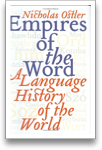
The biggest flaw of this book is that the prose is painful to read; certain passages require two or more readings before being understood. Despite this, I would recommend this book for the in-depth overview of the history of languages around the world. I was also impressed with the typesetting of numerous obscure languages and their associated glyphs.
The fundamental question of this book is to ask how— in what circumstances and with what dynamics— language communities have come to flourish in the past, as well as how some of them have declined and even met their ends.
The Western Roman Empire was throughly overrun by German-speakers in the fifth century... so why did German get left behind? It changed for good all the crowned heads, it left France, Spain and Northern Italy still speaking variations of Latin, and they have gone on doing so to this very day. In Africa, Egyptian had been surviving foreign takeovers for over three millennia: why did it shrivel and dissappear after the influx of Muhammad's Arabic? And in the modern era, the Netherlands had ruled the East Indies for the same period that Britian ruled India: so why is Dutch unknown in modern Indonesia?
With the exception of Chinese, even the languages that originated writing systems, and so made the earliest use of it, have dropped their original system and borrowed another. In some sense, then, when one language replaces another, a people's view of the world must also be changing.
“Architecture: World's Greatest Buildings” by Jonathan Glancey
Score: 3.5+/4
• content: .5 • writing: 1 •
production: 1+ • enjoyment: 1

“Architecture: World's Greatest Buildings, Styles and History, Architects” (Eyewitness Companions series), by Jonathan Glancey, is written for the reader who will enjoy combining their love for travel with their love for architecture. In the introduction, the author regrets not being able to to catalog every single one of the world's marvels of architecture into a book that is compact enough to fit into a knapsack. So he has limited the catalog to the places he has travelled; at 512 pages, he is an experienced traveller.
The 16th century teamaster Sen-no-Rikyu created a garden enclosed by a tall hedge that blocked the view of the sea from the house that stood within its walls. When the client first walked through the garden, he was unhappy, until he bent to wash his hands in a stone basin. As he lifted his eyes from the refreshing water, the sea was clearly visible through a precise gap in the hedge. The client smiled. He understood, intuitively, the clever connection Sen-no-Rikyu had made between the water in the basin and the waters of the ocean beyond, and so between himself and the infinite universe.
From a note about Japanese gardens.
The book begins with an overview of the purpose for architecture ("the self-concious act of building, not just with common sense, but with artistry") and the first civilizations that practiced it (Mesopotamia, 5000 BCE) and those that (some would say) perfected it to an ideal (the Greeks). Every page is filled with many full-colour photos of nearly all of the buildings discussed on that page; it has at least one 3-D computer generated rendering of an important building in each architectural era, including a re-construction of the Acropolis (now mere ruins on a hill near Athens). For each architectural period, the book summarizes the key elements that identify the era.
There is, understandably, a slight bias towards English architects— the last building mentioned in the book is the Swiss Re building in London, designed by Norman Foster (I love his ceiling of the Great Court at the British Museum). The Stata Center (the "broken buildings", as my nephew refers to them) on the MIT campus, designed by Gehry are notably absent either because the book went to press before they were completed or the author hadn't travelled to Cambridge to see them in person.
My main reason in buying this book was so I could identify the architectural styles of many of the buildings in downtown Toronto. After reading the chapter on Classical greek architecture, I was able to identify the style and period of Union Station, where I arrive and depart to/from home and work, and the Dominion Building located just one block away. I am not using the book as it was intended, but rather as a primer for learning about architecture (it has an excellent index and comprehensive glossary of architectural terms).
Many of the chapters, including the ones on Asian architecture, will only serve as historical references that complete my knowledge of architecture— I have neither the intention nor the interest of ever traveling to these far-off places (I don't have a Ranger to guide me nor a grey wizard that will rescue me from mortal peril)— I am quite content seeing the world through people's vacation photos.
“Abel's Proof” by Peter Pesic
Score: 1/4
• content: 0 • writing: 0 •
production: 1 • enjoyment: 0
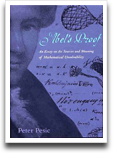
If you read and enjoyed books like Genius, The Man Who Knew Infinity and Fermat's Enigma, and you expect this book to be of the same type, then you will be dissappointed.
The first 6 chapters are devoted to all the history leading up to Abel, who uses the foundations set by other great mathematicians like Pythagoras, Euclid, Descarte, Lagrange, Newton, et al., to make his great discovery. Abel doesn't not make an appearance until Chapter 7 and his appearance is as brief as his life of 26 years.
I only purchased this book because of a favourable review from The Economist magazine. If I had seen this book in a bookstore and used my "rule of thumb" for buying books— start reading the first chapter and if you can't put it down, buy it— then this book would have failed miserably; the first chapter is the most boring chapter about mathematics, I have ever read.
Abel's Proof is not a book, but as the subtitle indicates (An Essay on the Sources and Meaning of Mathematical Unsolvability), it is a brief essay; this book can be easily read in a day or two and only a mathematician will appreciate it fully.